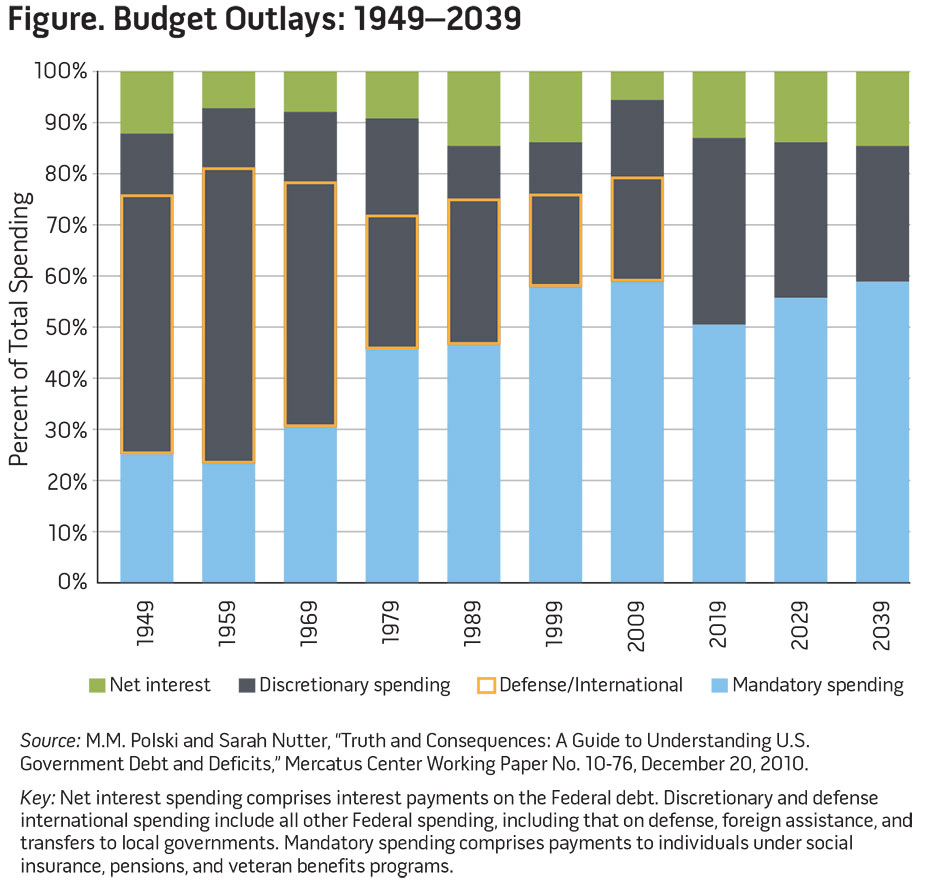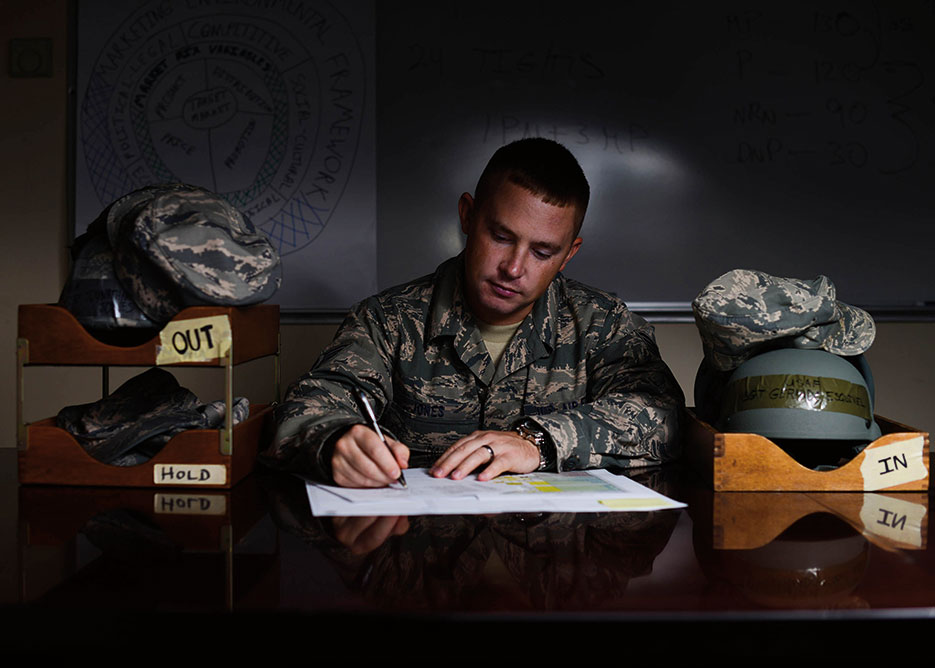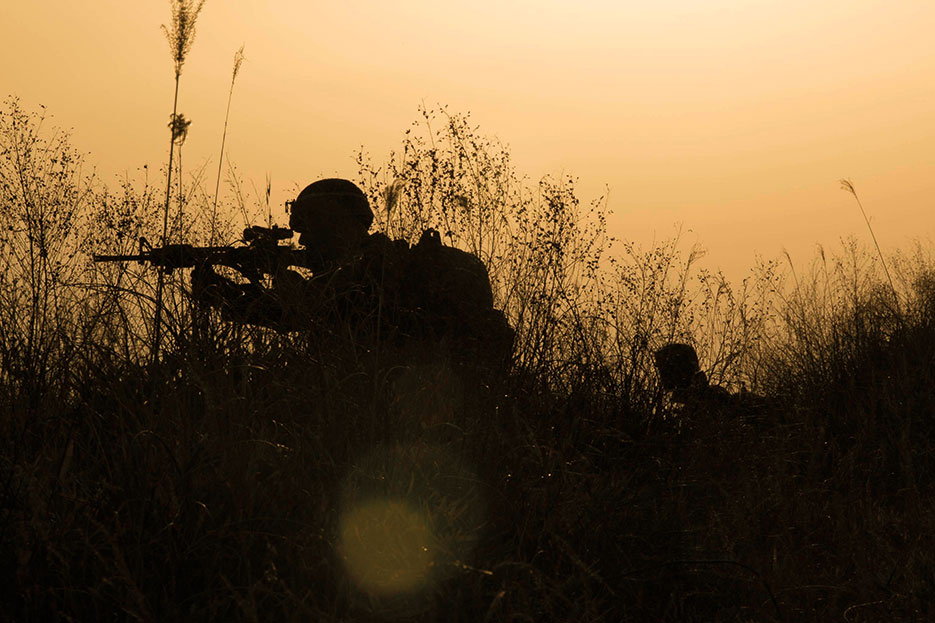Журнальный клуб Интелрос » Joint Force Quarterly » №81, 2016
The heart of the challenge is this: as we move into an uncertain future we must get better as we get smaller.
—General John M. Shalikashvili, USA
There is widespread concern and a great deal of collective handwringing these days about defense strategy. Seasoned observers will note that this is not a new problem. The environment that General Shalikashvili described in introducing the 1994/1995 Autumn/Winter issue of Joint Force Quarterly in the epigraph above is strikingly familiar 20 years later: conflicts in regions formerly at peace, the changing role of alliances and the range of situations in which we are called upon to use the military, the ambiguity and proliferation of threats around the world, and the ever-quickening pace of change in science and technology that nourishes competitors and substantially reduces the time it takes for a force to go from state-of-the-art to obsolescence.

Marine currently embarked aboard littoral combat ship USS Fort Worth (LCS 3) performs sight survey on Jikdo Island, Republic of Korea, as part of training exercise during Foal Eagle 2015 (U.S. Navy/Conor Minto)
Moreover, in fiscal year 1995, the Armed Forces also confronted declining defense budgets and military resources. The figure shows that mandatory and net interest expenses have been fairly consistently crowding out discretionary spending since 1979. An analysis of current Congressional Budget Office projections leads us to expect that the next decade will look a lot like 1999: annual defense and international budgets are likely to average 13 percent of total budget outlays, or about 2.8 percent of gross domestic product, over the period 2016 to 2026.1

Nor have topical issues changed much since General Shalikashvili’s tenure. The above-referenced issue ofJoint Force Quarterlyfocused on a new defense consensus, Service identities and joint culture, civilian control of the military, information warfare, and joint operations in the civil war. It should be no surprise that strategic priorities top the list. Reflecting on strategic issues in his introduction to the issue, Shalikashvili argued that the Armed Forces were facing revolutionary challenges that required radical changes in how we think about, plan, and build our defenses. Over the course of his term as Chairman of the Joint Chiefs of Staff, General Martin Dempsey not only confronted similar circumstances but also appealed for innovation and transformation.
The call to innovate and transform falls squarely in the strategist’s wheelhouse. But it is not entirely clear how a military strategy organization should respond to this demand. Some people quip that innovation in a military organization is an oxymoron, noting that it is extraordinarily difficult for large hierarchical organizations that dominate their area of operation in the near term to willingly transform themselves into revolutionaries.
To help address these concerns, the Center for Naval Analyses recently completed a comparative study of strategy activities in the Army, Marine Corps, Navy, and Air Force to identify common challenges, alternative approaches, and potential opportunities for change.2 The following is a summary of our findings and further reflections on how the Armed Forces could nurture revolutionary change without compromising their ability to meet the not-so-revolutionary requirements of the near term.
One More Time: What Is Strategy?
A well-trained analyst learns that he or she cannot study something with rigor until it has been defined. But as we learn from painful experience, definition is often one of the problems that plagues a sponsor’s presenting challenge. And despite considerable reflection and extensive doctrine, military strategy is beset with definitional issues.
Joint Publication 3-0, Joint Operations, defines strategy as follows: “A prudent idea or set of ideas for employing the instruments of power in a synchronized and integrated fashion to achieve theater, national, and/or multinational objectives.”3 Among strategists, the typical shorthand definition has something to do with integrating ends, means, and ways to achieve national security objectives.
Our doctrinal definition would no doubt satisfy Carl von Clausewitz, who defined strategy as “the use of engagements to attain the object of the war,” which is “a mere continuation of policy by other means.”4 Similarly, it is consistent with B.H. Liddell Hart’s definition of strategy as “the art of distributing and applying military means to fulfill the ends of policy.”5
While every strategist we met could recite some version of these definitions of strategy, we found quite a few who were dissatisfied with them. What most worries them is the tendency to conflate strategy and planning. Whereas planning is focused on operations, tactics, and effective execution, strategists prefer to focus on something grander that they just cannot quite put their collective finger on.
Turning to more modern texts for guidance, we consulted Lawrence Freedman’s recent tour de force, Strategy: A History. With reference to history and drawing on studies in philosophy, military studies, social science, and management, Freedman ultimately characterizes strategy as the art of getting more out of a situation than the starting balance of power would suggest, or “the art of creating power.”6 Unfortunately, Freedman’s definition also fails to satisfy military strategists. But we liked the pithy approach, so whenever possible we asked strategists to complete the sentence: “Strategy is the art of . . .” While we found that strategists readily embrace the notion of strategy as an art and often like to talk about beginning with a blank canvas, this exercise failed to define that certain je ne sais quoi that strategists appear to strive for but cannot specifically articulate. After trying but failing to come up with a satisfying alternative, strategists default to doctrine.
In my view, the most interesting aspects of our findings regarding definitional issues are threefold. Foremost, none of the more than 75 military strategists we spoke with defined strategy with reference to rivalry or competition. Although some strategists worried that an emphasis on planning tends to obscure a realistic assessment of the environment or particular strategies, no one included rivalry or competition as a part of their definition. Yet Sun Tzu, whose classic treatise The Art of War appears on every professional military education strategy course syllabus, emphasizes the importance of “the art of the attack,” which specifically involves understanding relative strength, perceiving intentions, and calculating strategic advantage.7
Second, while strategists intellectually understand that there is an interdependent and iterative relationship between policymaking, strategy, and planning that is reinforced in Title 10 authorities, there is a persistent and contradictory tendency to demand top-down guidance.8 Many strategists complain that they cannot produce strategy if they do not have up-to-date national security strategy.9 Some crave precise guidance on priorities and resources.10 These demands, as we shall see in the findings that follow, undermine the potential value of strategy activities in the Armed Forces.
Finally, there is a tendency in the strategy community to focus on products and primers rather than analysis, vision, or effective processes. This is illustrated by a proliferation of strategies across the Department of Defense and the interagency community. Noting that the list is not all inclusive, Joint Publication 5-0, Joint Operations Planning, lists 15 additional sources of national strategic guidance beyond those produced in the joint planning system.11
There has been a similar proliferation of strategies within the Services. Service chiefs compound the problem when they task multiple units with strategy issues or create additional working groups without also creating a coordination mechanism to facilitate deconfliction, alignment, and communication. Strategists point out that less is more when it comes to strategy: too many strategies create strategic confusion, which ultimately decouples strategy from other critical processes.
Common Challenges
Military strategists struggle with a number of other issues beyond definitional matters. Title 10 authorities and the peculiarities of American Federalism dictate that strategy has many masters. However, as some of our respondents ruefully pointed out, almost everyone likes to talk about strategy but few want to do it—particularly today. While each of the Services has unique strategic challenges, a number of common issues emerged in our study.
Not only has there been a proliferation of strategies and strategy activities, but also both strategy producers and consumers indicate that it is often difficult to distinguish between strategy to organize, equip, and train the force; warfighting; and organizational change initiatives. The current environment is producing weak and often conflicting signals for strategy and resource allocation. Current events in domestic and international environments, policy conflict, sequestration, pervasive crises, demographic factors, the volatility and restructuring of the global political economy, and innovation in science and technology create noise and rapid shifts in demand that make it difficult for strategists to keep up.
While some signal distortion is to be expected in an uncertain environment, we found that both strategy producers and consumers are asking fundamental questions that suggest a pervasive absence of strategic vision and leadership, such as “Strategy for what?” “Which strategy?” “What are our real priorities?” “How are resources tied to strategies?”
In what Yogi Berra would call “déjà vu all over again,” we also found that each of the Services is reevaluating its “value proposition,” or how it will contribute to joint warfighting now and in the future. While this kind of reexamination is painful to undertake, in my view it is to be expected after a decade of war, and it should be welcomed as we grapple with future requirements.
Meanwhile, strategists report that Service chiefs are focused on sustaining and defending near- and medium-term resources and capabilities and developing more efficient and effective organizations. Programmers rule while more strategy focused efforts to understand the implications of rapid advances in science and technology and the emerging capabilities and intentions of near-peer competitors languish.
Despite the obvious need for strategy, we found widespread concern across the Department of Defense about the quality of strategic thinking. Decisionmakers and planners are concerned that they are not adequately anticipating change in the environment and that professional military education is not keeping up with requirements.12 Many feel that personnel management systems create incentives that inhibit strategy education, training, and career progression. Strategists complain about how strategy assignments and time out for education and teaching are treated in promotion decisions as well as the impact of the “up or out” rule in developing and retaining soldiers with critical knowledge and skills.
Finally, some strategists are concerned about the validity and reliability of current decision analysis tools and approaches. Potentially useful innovations that have been developed in defense research communities, which leverage advances in the computational and complexity sciences, have not been fully disseminated into strategy education and practice.
Taken together, these challenges indicate that key strategy functions, core competencies, and process are underdeveloped or poorly aligned.

Center for Information Dominance Corry Station oversees career management and training for officer and enlisted students of U.S. military and allied forces in fields of information warfare, information professional, cryptologic, and information technology, May 2011 (U.S. Navy/Gary Nichols)
Key Strategy Functions
Four types of functions emerged from our analysis of strategy organizations and activities across the Services: supporting decisionmaking, anticipating and shaping demand, meeting demand, and developing the next generation.13 Key strategy functions are interdependent: activities and outcomes feed and reinforce each other. While each of the Services has efforts under way to improve strategy capabilities, we did not find any Service in which all four functions are fully operational or tightly integrated.
Functional activities that support decisionmaking include organizing and facilitating decisionmaking events, developing analyses and tools to inform decisionmaking, and making recommendations.
Activities associated with anticipating and shaping demand for strategy include collecting data; building networks of relationships; participating in internal and external analytical and decisionmaking processes; identifying and communicating patterns and trends; forecasting, wargaming, and engaging in other types of simulations, exercises, and experimentation; organizing inquiries and meetings; and producing innovative concepts or analyses that challenge prevailing thinking or practice.
Functional activities associated with meeting demand for strategy include responding to requests for strategic information or analyses, communicating about strategy, developing strategies, and organizing and participating in long-range planning processes.
Developing the next generation of strategists includes activities such as promoting the value of strategy and strategic practice; creating communities of practice; educating, training, coaching, and mentoring; and promoting capable strategists into positions of organizational authority and influence.
Core Strategy Competencies
We define core strategy competencies as sets of knowledge, skills, and abilities associated with successfully performing key strategy functions. We derived our list of core competencies by analyzing strategy careers; the types of activities that strategists reported performing; strategy organizations; linkages with other critical areas, such as budgeting, programming, and capital investment; and Service operating styles. Four core strategy competencies emerged from our analysis:
Tactical expertise is the foundation of military excellence in all the Services, but good strategists are visionary generalists: they are Jacks or Jills of all trades but masters or mistresses of none. No strategist can be an expert in all four areas of core competency. Instead, we found it imperative that they are familiar with each of these areas and can quickly and fearlessly identify and draw upon needed expertise. Strategists told us that it is important to effectively work across functions and organizations. To do so, they must have the skills to cultivate mutually beneficial relationships with counterparts, wherever they reside.
Our analysis suggests that the military strategy community may need further development in core competencies related to analysis; in professional program management and planning; and in its knowledge of budgeting, programming, force planning, capital investment, economics, business, finance, governance, and developments in science and technology.

Manpower Airmen work hand in hand with units and independent innovation working group to discover new ways to enhance Aviano Air Base’s performance during time of dwindling resources, June 2015 (U.S. Air Force/Austin Harvill)
Developing Strategies
Our analysis identified three types of strategy development processes: duty strategy, evolutionary strategy, and transformational strategy. Real strategy processes and products are classified. Duty strategy processes meet bureaucratic demands for strategy inputs that arise from routine planning processes or crises. Evolutionary processes meet the need to regularly review, update, and adapt existing strategies. Transformational processes meet the need to rethink and radically change the way that the Services will fight in the future.
Duty and evolutionary strategy processes involve extensive coordination across functions and organizations. They rely on a consistent core group of trained and disciplined analysts with operational expertise, a well-defined organizational structure, and widely understood authorities and operating procedures. Typically, transformational processes are relatively short lived, expert led, and custom tailored to meet senior leadership needs. They look 30 to 40 years into the future and create alternative ways of promoting and defending vital interests.
We found good contemporary examples of duty and evolutionary strategy processes in the Services. However, there is a clear need across the Services to reduce the number of strategy products and to rationalize processes to better integrate strategy with resource allocation and research and development activities.
Transformational strategy is a greater challenge and a pervasive need across the Department of Defense. We had to reach back in time to the Air Force’s “mission-pull” strategy exercises in the late 1990s to find a tested process. Originally developed by the Office of the Secretary of Defense, the mission-pull approach involves specifying the long-term future security environment (30 years out) and disaggregating it into operating environments, missions, and critical tasks. Senior leaders create a future Service by imagining and debating several alternative concepts of how they will fight. Consensus around a particular vision provides the basis for evaluating competing resource requirements.14
Strategy process requirements depend on the type of strategy that senior leaders demand and on the larger organizational environment.15 There is a great deal that strategists can do to shape demand for strategy; however, their influence is a direct function of senior leadership commitment and support. Even a high-functioning strategy organization cannot compensate for an absence of senior leadership receptivity and creativity. When leaders are unable or unwilling to think and act strategically, strategists can only soldier on, redouble shaping efforts, and prepare for opportunities to emerge from changes in leadership or the environment.
Implications and Concluding Thoughts
Our study has a number of implications for the Chairman, Service chiefs, and Department of Defense. First, regarding the debate about whether the strategy problem is a people problem or a process problem, it is clear that people, structures, and processes all matter. Our analysis suggests that capable people and strategic vision can be defeated by inadequate organizational structures and that inadequate people can defeat well-designed structures and processes. Current events and trends suggest that we need to ensure that we develop and promote highly competent strategists, rationalize strategy organizational structures and products, and undertake transformational strategy development processes.
Let us begin with people. Our analysis indicates that there is a significant risk that current investments in developing the next generation of strategic leaders may not align with key strategy functions and core competencies. The U.S. Armed Forces are a joint force, and this is not likely to change over the next generation. This means that strategy and the development of strategic leadership are a joint function. It is time to build a joint strategy community and to rationalize and align strategy education and training. While each Service must make its own determination about how it develops, coaches, and mentors future leaders, only those who can demonstrate joint strategic competence should be promoted to general/flag officer. Our lives and the future peace and prosperity of our country depend upon their strategic, operational, and tactical expertise.
Our organizational structures are a strategic nightmare. Federalism in a large and boisterous democracy such as the United States breeds polycentricism: many independent centers of decisionmaking and control.16 However, the solution to marshaling these forces is not to centralize command and control; polycentric structures are difficult to penetrate, which can be a strategic advantage, and they are adaptive. What is needed to overcome the strategic disadvantages of polycentricism is better coordination, which is achieved by empowering capable people, reducing unnecessary activities, developing resilient networks, and implementing sustaining processes.
The way to go about improving joint coordination will be tedious but straightforward if the Chairman and Joint Chiefs are ready and willing to lead the way in making organizational change across the joint planning system and the Services. Efforts could begin immediately to:
The 2015 leadership transition year was a critical moment for implementing change. Moreover, the current environment provides ample opportunities for the Joint Chiefs to innovate. However, successful organizational change management efforts require a disciplined process, team effort, strong senior leadership, and independent expertise. Internal personnel often do not have the time, experience, or interest to envision and implement change while attending to current responsibilities. And even welcome change involves addressing sensitivities and entrenched interests that are difficult for current staff to identify and manage. Independent analysts provide objective perspective and extra hands on deck to assist a change management team with process management, data collection, analysis, design, and implementation activities.
Cognizant of the challenges presented by the revolutionary changes he foresaw 20 years ago, General Shalikashvili provided guidance that is worth revisiting and updating to meet today’s requirements. Arguing that we must hedge against the future, not the past, he urged us to take prudent risks and invest in resources for the future. His words provide a fitting conclusion for this article: “Yet we cannot retreat, we must go forward. I am confident that we will triumph in these revolutions and that our Armed Forces will remain the most formidable in the world.” JFQ

Marines post security on patrol during Forest Light 15-1 at Oyanohara Training Area in Yamato, Kumamoto Prefecture, Japan (U.S. Marine Corps/Warren Peace)
Notes
1 Author’s compilation based on the Congressional Budget Office (CBO), The Budget and Economic Outlook: 2015–2026 (Washington, DC: CBO, January 2016).
2 We designed and conducted a modified data-driven business process analysis of how each of the Services was developing and aligning resources with strategy during the period October 2014 through December 2014. The goal of our analysis was to identify key strategy functions, core competencies, and examples of types of strategy organizational structures and processes. The study generated a high-level description of efforts under way in each of the Services to better align strategy with resource allocation. We did not assess the quality or value of Service strategies or strategy organizations and activities. A comprehensive analysis, which would include detailed business process mapping and analyses of resources, requirements, and performance, was beyond the scope of this study.
3 Joint Publication (JP) 3-0, Joint Operations (Washington, DC: The Joint Staff, August 11, 2011).
4 Carl von Clausewitz, On War (New York: Modern Library, 2000 [1832]), book II, chapter 1; book III; and book I, chapter 1 (24).
5 B.H. Liddell Hart, Strategy (London: Faber and Faber, 1967 [1954]), chapter XIX.
6 Lawrence Freedman, Strategy: A History (New York: Oxford University Press, 2013), xii.
7 Sun Tzu, The Art of War (New York: Modern Library, 2000), chapters 1, 3. For an analysis and comparison of the differences between Western and Chinese military thinking, see Francois Jullien, A Treatise on Efficacy: Between Western and Chinese Thinking (Honolulu: University of Hawaii Press, 2004). Additional perspective is found in Fumio Ota, “Sun Tzu in Contemporary Chinese Strategy,” Joint Force Quarterly 73 (2nd Quarter 2014).
8 Service strategy organizations serve the chief and secretary. According to Title 10 and relevant doctrine and policy, the role of a Service chief and Service secretary includes advising senior leaders in developing and achieving realistic national security objectives; directing operational design, analysis, and planning; organizing, training, and equipping the force; providing appropriate doctrine, concepts, and operating instructions; allocating resources to achieve short-, medium-, and long-term objectives; and representing the Service in foreign and domestic security cooperation activities.
9 We duly note the potential for strategic withholding among those who disagree with policy but are compelled to comply within the chain of command.
10 Ibid.
11 JP 5-0, Joint Operations Planning (Washington, DC: The Joint Staff, August 2011), figure II-3.
12 We found that both the Office of the Secretary of Defense (Policy) and the Joint Staff J7 have undertaken analyses of professional military education (PME) to identify opportunities for innovation and reform. A 2010 House Armed Services Committee report was specifically critical of strategy PME: “Joint and Service efforts to cultivate military strategists are disassociated and producing mixed results. The committee recommends each of the Services carefully review and coordinate their PME efforts with the goal of educating qualified strategic decisionmakers, and that they should consider sponsoring additional junior officers for advanced degrees in top-tier civilian universities. These officers should be considered for command, staff, and faculty positions.” See House Armed Services Committee No. 111-67, Another Crossroads? Professional Military Education Two Decades after the Goldwater-Nichols Act and the Skelton Panel, Hearing before the Oversight and Investigations Subcommittee, 111th Cong., 1st sess., May 20, 2009.
13 We define a function as a core set of policies, procedures, and processes that enable people to carry out specific responsibilities associated with a particular area of organizational performance, such as strategy. Note that our focus in the cross-Service study was to identify functions, not to assess quality or performance.
14 For a description of the mission-pull approach, see Clark A. Murdock, “Mission-Pull and Long-Range Planning,”Joint Force Quarterly 6 (Autumn 1994/Winter 1995). We are grateful to Dr. Murdock, who helped the Air Force implement mission-pull in the late 1990s and early 2000s, for his generosity in sharing his experience and working papers. Dr. Murdock’s book, Future Making: Getting Your Organization Ready for What’s Next (Stevensville, MD: Murdock Associates, 2007), provides additional guidance and applications.
15 The larger organizational environment for strategy includes authorities to act, history, culture, operating style, resources, initiatives under way, leadership transitions, events, fiscal constraints, and political cycles.
16 For an analysis of polycentricity in American political and administrative life, see the work of Vincent Ostrom, including A Political Theory of a Compound Republic: Designing the American Experiment, 3rd ed. (Lanham, MD: Lexington Books, 2008); The Meaning of Federalism: Constituting a Self-Governing Society (San Francisco: Institute for Contemporary Studies Press, 1994); and “Polycentricity,” a conference paper presented at the annual meeting of the American Political Science Association, Washington, DC, September 5–9, 1972, which is reprinted in Polycentricity and Local Public Economies: Readings from the Workshop in Political Theory and Policy Analysis, ed. Michael McGinnis (Ann Arbor: University of Michigan Press, 1999).